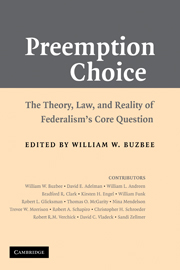Book contents
- Frontmatter
- Contents
- Contributors
- Acknowledgments
- Introduction
- Part I FEDERALISM THEORY, HISTORY, AND PREEMPTION VARIABLES
- Part II THE LAYERED GOVERNMENT NORM
- 4 The State Attorney General and Preemption
- 5 Federal Floors, Ceilings, and the Benefits of Federalism's Institutional Diversity
- Part III JUDICIAL TREATMENT AND INTERPRETIVE CHOICE
- Part IV PREEMPTION TALES FROM THE FIELD
- Index
5 - Federal Floors, Ceilings, and the Benefits of Federalism's Institutional Diversity
Published online by Cambridge University Press: 07 July 2009
- Frontmatter
- Contents
- Contributors
- Acknowledgments
- Introduction
- Part I FEDERALISM THEORY, HISTORY, AND PREEMPTION VARIABLES
- Part II THE LAYERED GOVERNMENT NORM
- 4 The State Attorney General and Preemption
- 5 Federal Floors, Ceilings, and the Benefits of Federalism's Institutional Diversity
- Part III JUDICIAL TREATMENT AND INTERPRETIVE CHOICE
- Part IV PREEMPTION TALES FROM THE FIELD
- Index
Summary
INTRODUCTION
Federal regulatory schemes commonly utilize cooperative federalism structures and involve standard setting or other federal actions that serve as a regulatory “floor.” Such floors preempt and thereby preclude any more lax regulatory choices by state or local governments. With such floors, state and local governments, and common law schemes as well, all can impose either more stringent regulatory requirements or common law incentives to create less risk. With the partial preemption of regulatory floors, targets of regulation often confront multiple lawmakers and overlapping regulatory obligations. Another sort of federally preclusive action, so-called ceiling preemption, is also possible but has been far less common. Regulatory ceilings involve federal actions or standard setting that preclude additional, more protective regulatory choices by other levels of government and sometimes can preclude common law liabilities. But these two sorts of preemptive actions reflect more than just choices about the levels of protection provided by regulation. When one works through the logic of federal actions and the implications of the Supremacy Clause, so-called ceilings actually constitute a unitary federal choice precluding other actors' ongoing interaction and revisiting of earlier regulatory choices. Regulatory floors, in contrast, provide an array of regulatory benefits lost with the far more completely preclusive “ceiling preemption.”
This is not to claim that ceilings or more fully preemptive federal actions do not have their place.
- Type
- Chapter
- Information
- Preemption ChoiceThe Theory, Law, and Reality of Federalism's Core Question, pp. 98 - 116Publisher: Cambridge University PressPrint publication year: 2008

